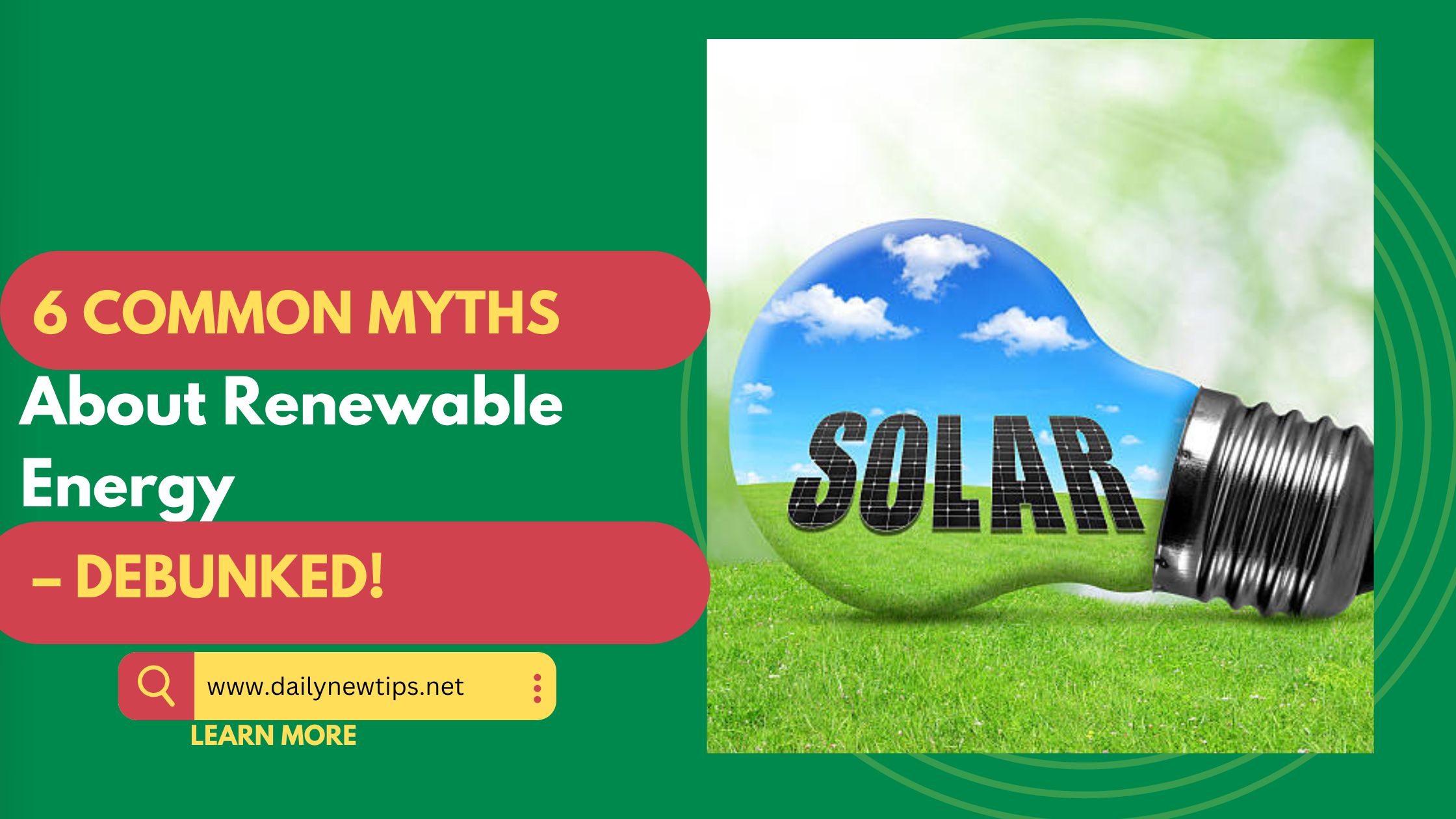Introduction
6 Common Myths About Renewable Energy – Debunked!
Renewable energy is steadily gaining traction as a clean, sustainable solution for the future, but misconceptions still abound. These myths often prevent individuals and businesses from fully embracing green energy. Let’s take a closer look at six of the most common myths about renewable energy and set the record straight.
6 Common Myths About Renewable Energy – Debunked!

1. Renewable Energy is Too Expensive
Debunked: While the initial setup costs for renewable energy sources like solar panels and wind turbines can be high, technological advancements have significantly lowered costs. In fact, renewable energy is becoming more cost-effective than fossil fuels over the long run, thanks to savings on energy bills and government incentives. For example, solar energy prices dropped by over 80% in the last decade.
2. Renewable Energy Can’t Meet Demand
Debunked: Critics often argue that renewable energy sources are insufficient to meet global energy needs. However, studies show that the Earth receives enough solar energy in just one hour to power the entire planet for a year. Coupled with advancements in storage technology and diversified energy grids, renewable energy has the potential to handle large-scale demands.
3. Wind and Solar Power are Unreliable
Debunked: It’s true that the sun doesn’t always shine, and the wind doesn’t always blow. However, modern solutions like battery storage systems, energy forecasting, and complementary energy sources (e.g., hydropower or geothermal) make renewable energy more dependable than ever. Countries like Germany and Denmark already source nearly half their energy from renewables, proving their reliability.
4. Renewable Energy Harms the Environment
Debunked: While there is some environmental impact during the construction phase of renewable energy projects, these sources significantly reduce greenhouse gas emissions compared to fossil fuels. Wind turbines and solar panels operate without releasing carbon dioxide, making them environmentally friendly over their lifecycle.
5. Switching to Renewables Will Destroy Jobs
Debunked: On the contrary, the renewable energy sector is creating jobs at an unprecedented pace. According to the International Renewable Energy Agency (IRENA), the renewable energy industry employs over 12 million people worldwide, and this number continues to grow as more nations adopt green technologies.
6. Renewable Energy is Just a Trend
Debunked: Renewable energy is far from a passing trend. It is a critical component of global efforts to combat climate change and reduce dependence on finite resources. Governments and businesses worldwide are setting ambitious goals to achieve 100% renewable energy in the coming decades, proving its importance for a sustainable future.
Tips for Adopting Renewable Energy
- Start Small: Consider beginning with solar panels or energy-efficient appliances before transitioning fully to renewable energy.
- Utilize Incentives: Research government subsidies or tax credits that can reduce the upfront cost of installation.
- Understand Your Needs: Evaluate your energy consumption to choose the right type of renewable source.
- Partner with Reputable Providers: Choose certified, experienced companies to ensure quality installations and service.
Benefits of Renewable Energy
- Environmental Preservation: Reduces greenhouse gas emissions and combats climate change.
- Cost Savings: Lowers energy bills in the long run, especially with advancements in technology.
- Energy Independence: Minimizes reliance on finite fossil fuels and unstable energy markets.
- Job Creation: Supports millions of jobs in the growing renewable energy sector.
Suggestions for Promoting Renewable Energy
- Educate Communities: Share accurate information and success stories about renewables to dispel myths.
- Support Policies: Advocate for policies that encourage clean energy adoption and innovation.
- Collaborate: Businesses can collaborate with local governments to launch community solar projects or renewable initiatives.
- Invest in Research: Support technological advancements like better energy storage solutions for wider adoption.
How can individuals transition to renewable energy?
Transitioning to renewable energy can be a gradual and rewarding process. Here’s a step-by-step guide to help individuals make the shift:

1. Assess Your Energy Needs
- Start by analyzing your current energy consumption. Look at your electricity bills to understand how much energy you use and what appliances or systems consume the most.
2. Make Energy Efficiency a Priority
- Before transitioning, reduce your overall energy usage by adopting energy-efficient practices:
- Replace incandescent bulbs with LEDs.
- Use smart thermostats to optimize heating and cooling.
- Invest in energy-efficient appliances.
3. Start Small with Renewable Energy
- Begin with small installations like:
- Solar Water Heaters: A cost-effective way to start harnessing solar energy.
- Rooftop Solar Panels: Even a small solar array can power parts of your home and reduce electricity bills.
- Portable Solar Chargers: Ideal for charging smaller devices like phones and laptops.
4. Take Advantage of Incentives
- Research government programs, rebates, and tax benefits that can reduce the cost of installing renewable energy systems. In India, for example, subsidies for solar panel installations are available under schemes from the Ministry of New and Renewable Energy (MNRE).
5. Explore Off-Grid Solutions
- For those in rural or remote areas, off-grid solutions like standalone solar systems or micro wind turbines can be an excellent option to achieve energy independence.
6. Partner with Reputable Companies
- Choose certified renewable energy installers and providers to ensure quality systems and efficient after-sales service.
7. Educate Yourself and Others
- Learn about the long-term benefits of renewable energy and share your knowledge with family, friends, or your community to promote its adoption.
Remember: Every small step counts. Whether you’re switching a single appliance or installing a complete solar array, your efforts contribute to a cleaner, greener future! Let me know if you’d like help exploring specific renewable options further.
Conclusion
Renewable energy is more than an alternative—it’s the foundation for a sustainable future. By understanding the facts and benefits, individuals and organizations can contribute to a cleaner planet, lower energy costs, and a healthier global economy. Let’s move forward by adopting green energy solutions with confidence.
FAQs About Renewable Energy
Q: What are the challenges of using renewable energy?
A: While upfront costs and intermittency are concerns, advancements in storage and grid systems are addressing these issues.
Q: Can renewable energy fully replace fossil fuels?
A: With proper investment and innovation, renewables can provide sufficient energy while reducing environmental impact.
Q: What are the main types of renewable energy?
A: The main types of renewable energy include:
- Solar Energy: Harnessing sunlight through solar panels or solar thermal systems to generate electricity or heat.
- Wind Energy: Using wind turbines to convert wind power into electricity.
- Hydropower: Generating electricity by capturing the energy of flowing or falling water, such as in dams.
- Geothermal Energy: Utilizing heat from the Earth’s core to produce electricity or provide direct heating.
- Biomass Energy: Converting organic materials like wood, agricultural waste, or manure into energy through combustion or other processes.
- Tidal and Wave Energy: Capturing the kinetic energy from ocean tides and waves to generate electricity.
Each type plays a unique role in reducing dependence on fossil fuels and contributing to a sustainable future. Let me know if you’d like a deeper dive into any of these!
Q: Are there government incentives for switching to renewables?
A: Yes, governments worldwide offer various incentives to encourage the adoption of renewable energy. In India, for example, the Ministry of New and Renewable Energy (MNRE) provides schemes like the Grid Connected Rooftop Solar Programme and the National Bioenergy Programme, which include subsidies and financial support. Additionally, there are waivers on Inter-State Transmission System (ISTS) charges for solar and wind power projects.
Globally, incentives often include tax credits, grants, and rebates for installing renewable energy systems. These programs aim to reduce upfront costs and promote sustainable energy solutions. Let me know if you’d like more details on specific schemes!
References
- International Renewable Energy Agency (IRENA) reports on employment growth in the green energy sector.
- Studies on solar energy efficiency by the National Renewable Energy Laboratory (NREL).
- Reports on renewable energy advancements published by the World Economic Forum.
- read more

